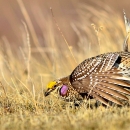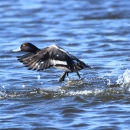About Us
This 1,674-acre Refuge supports a unique community of habitats including oak, ash, basswood, and aspen woodlands, mixed-grass prairie, and interspersed wetlands.
Our Mission
Each unit of the National Wildlife Refuge System is established to serve a statutory purpose that targets the conservation of native species dependent on its lands and waters. All activities on those acres are reviewed for compatibility with this statutory purpose.
The mission of the National Wildlife Refuge System is to administer a national network of lands and waters for the conservation, management and, where appropriate, restoration of the fish, wildlife and plant resources and their habitats within the United States for the benefit of present and future generations of Americans.
The following legislations and public land orders describe the purpose for White Horse Hill National Game Preserve:
- "All the lands that are now reserved or may hereafter be included within the boundaries of the...National Park Game Preserve...are hereby further reserved and set apart for the use...as refuges for breeding grounds for birds." (Executive Order 3596, December 21, 1921)
- "As a big game preserve, refuge, and breeding grounds for wild animals and birds...provided, that the said game preserve is to be made available to the public for recreational purposes in so far as consistent with the use of this area as a game preserve...provided further, that hunting shall not be permitted on said game preserve. " (46 Stat. 1509, Act of March 3, 1931)
Our History
White Horse Hill National Game Preserve boasts a unique and interesting history with records dating back to 1904. The following is a partial timeline of historical events related to the Refuge.
1904 - Enacted April 27, 1904, Public Law No. 179 authorized President Theodore Roosevelt to reserve a tract of land embracing [White Horse Hill] as a public park. The final Proclamation, No. 32, was signed on June 2, 1904, by President Roosevelt officially establishing [White Horse] Hill Park within the National Park Service system.
1906 - Charles M. Ziebach became the first manager of the park (1906-1913?)
1914 - Ten years after the Park was established, appropriations were made for the creation of a big-game preserve within the Park to be jointly administered by the Department of Interior, National Park Service and the Department of Agriculture, Biological Survey.
1916 - The big game fence was built to enclose a 700-acre tract of land designated for the introduction of bison, elk, and deer herds.
1917 - Fifteen elk arrived from Yellowstone National Park, and four deer were received from the Fargo Agricultural Experiment Station.
1918 - Six bison arrived from the Portland, Oregon, City Park.
1921 - On December 22, 1921, President Warren Harding, by Executive Order 2596, ordered that all lands within the boundaries of the Park be reserved and set apart as a refuge and breeding grounds for birds.
1930s - Sweetwater Lake was developed by the Works Progress Administration. Historical records show that through 1943, the Refuge used the services of the Works Progress Administration personnel, a depression-era program that was used for many public projects.
1931 - In the Act of March 3, 1931, President Herbert Hoover transferred the preserve from the National Park Service to the Biological Survey (which later became Fish and Wildlife Service) and renamed the park, Sullys Hill National Game Preserve to be administered as part of the National Wildlife Refuge System.
1948-1951 - The level of Devils Lake rose 14 feet.
1955 - Nesting colonies of pelicans and cormorants were seen on Rock Island. This was the second known nesting colony in North Dakota.
1966 - The first Audubon Christmas Bird Count was conducted at the Refuge.
1967 - A self-guided auto tour route opened. A newly developed vista turnout provided visitors with a spectacular view of Devils Lake.
1969 - The game preserve and the Devils Lake Wetland Management office were combined.
1970 - The rising level of Devils Lake necessitated raising Hwy 57 three feet. The Refuge lost 26 acres to flooding.
1975 - Black-tailed prairie dogs, originally only found west of the Missouri River, were introduced to the Refuge.
1978 - The auto tour route was paved.
1981 - Dutch Elm Disease infested the elm trees on the Refuge. Most of them died or were removed to prevent further spreading of the disease.
1985 - 1989 Wild turkeys were released on the Refuge however, turkeys released appeared to come and go from the Refuge.
1998 - The Sullys Hill Wildlife Refuge Society was formed as the first official Friends of Refuges organization in North Dakota. The group later changed it name to Friends of Sullys Hill as a national effort to better identify refuge friends groups with the refuge they support. They again changed their organizational name to Friends of White Horse Hill in 2020 to align with the refuge name change.
1999 - The refuge Friends group in coordination with the Refuge hosted the first ever North Dakota birding festival at the preserve and continued to host the event for 13 years.
2005 - A new 6,000 square foot visitor center was built as a result of Devils Lake flooding blocking the historical entrance to the Refuge.
2012 - Approximately 45 5th-grade students and their teachers from Devils Lake Central Middle School started morning classes at the Refuge. The program supports two units of 5th graders who complete a year-long program of integrated outdoor learning through the subjects of math, social studies, science, and language.
2019 - The Refuge was renamed by the U.S. Congress in December at the request of Spirit Lake Tribe to White Horse Hill National Game Preserve (Dakota: Sunka Wakan Ska Paha).
Today - The Refuge supports approximately 18-20 bison, 12-15 elk, a local prairie dog colony, and numerous species of land animals native to North Dakota. In addition, the Refuge supports over 214 species of resident and migratory birds. Come see for yourself what the Refuge has to offer!
Other Facilities in this Complex
White Horse Hill National Game Preserve is part of the Eastern North Dakota Complex. A National Wildlife Refuge Complex is an administrative grouping of two or more refuges, wetland management districts or other refuge conservation areas that are primarily managed from a central office location. Refuges are grouped into a complex structure structure
Something temporarily or permanently constructed, built, or placed; and constructed of natural or manufactured parts including, but not limited to, a building, shed, cabin, porch, bridge, walkway, stair steps, sign, landing, platform, dock, rack, fence, telecommunication device, antennae, fish cleaning table, satellite dish/mount, or well head.
Learn more about structure because they occur in a similar ecological region, such as a watershed or specific habitat type, and have a related purpose and management needs. Typically, a project leader or complex manager oversees the general management of all refuges within the complex and refuge managers are responsible for operations at specific refuges or wetland management districts. Support staff, may include administrative, law enforcement, refuge manager, biological, and fire, and are centrally located to support all stations within the complex.








